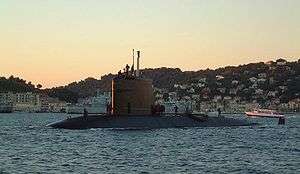French submarine Rubis (S601)
 | |
| History | |
|---|---|
| Namesake: | Ruby |
| Laid down: | 11 December 1976 |
| Launched: | 7 July 1979 |
| Christened: | as Provence |
| Commissioned: | 23 February 1983 |
| Renamed: | renamed Rubis in 1993 |
| Homeport: | Toulon |
| Fate: | In active service |
| General characteristics | |
| Class and type: | Rubis class submarine |
| Displacement: | 2600 t (2400 t surfaced) |
| Length: | 73.6 m (241 ft) |
| Beam: | 7.6 m (25 ft) |
| Draught: | 6.4 m (21 ft) |
| Propulsion: |
|
| Speed: | over 25 knots (46 km/h) |
| Range: | - |
| Endurance: | 45 days |
| Test depth: | over 300 m |
| Complement: |
|
| Sensors and processing systems: |
|
| Electronic warfare & decoys: | ARUR 16 |
| Armament: | |
The Rubis (S 601 ; ex Provence) is a first-generation nuclear attack submarine of the French Navy, named after the French submarine Rubis which distinguished herself during the Second World War.
Originally named Provence, she was renamed Rubis on 18 December 1980. Being the lead ship of the Rubis class, her fine-tuning was long, notably needing over 1000 hours of underwater testing before commissioning.
The Rubis is alleged to have entered the Pacific Ocean in 1985 to support the operation which led to the Sinking of the Rainbow Warrior. It is claimed that the submarine recovered the crew of the yacht Ouvéa before they could be re-arrested by New Zealand police for their role in the bombing of the Rainbow Warrior.[2]
The Rubis formed part of the French naval contribution to the Gulf War. Between September 1992 and July 1993, she undertook a major refitting which upgraded her to the level of the Améthyste. Soon after, on 17 July 1993, the Rubis collided with the tanker Lyria, as the Rubis was surfacing, causing minor damages and injuries.
The Rubis also took part in Operation Trident, the 1999 bombing campaign over Yugoslavia, by protecting the aeronaval group. Along with the Améthyste, she was one of the two submarines who interdicted the Kotor straits to the Serbian Navy, thus effectively forbidding its use. She also gathered information for the coalition.
In 2002, the Rubis protected Task Force 473 in the Indian Ocean, during operation Hercules, the naval part of the invasion of Afghanistan.
On 18 July 1996, the fourragère of the Ordre de la Libération was given to the submarine and her crew, as a legacy of the Rubis of the Second World War, which had been awarded the medal.
On 30 March 2007, while submerged, Rubis hit the bottom, damaging her bow and sonar. She returned to operations in July 2008.[3]
Rubis is expected to be decommissioned in the beginning of 2017.[4]
-

tampion of the Rubis
References and notes
- ↑ "The Bombing of the Warrior". Rainbow Warrior home page. Greenpeace. Archived from the original on March 10, 2012. Retrieved November 4, 2014.
- ↑ Sous-marin nucléaire d'attaque Rubis, netmarine.net
- ↑ (French) Déconstruction : le SNA « Rubis » attendu début 2017 à Cherbourg, le marin.fr